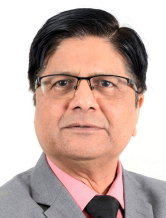|
 Mr. Amit
Dave
M. Pharm, MBA,
Former CEO - Brazil Operations/ Vice President Export
– Zydus Cadila/Claris Lifesciences |
Brazil Highlights
• Significantly large market for medical devices
• Regulatory Framework like the other LATAM counties
• Half of the market is catered by imported products
Country Profile
While returning from the
LATAM market during the recent tour, the author
travelled through Brazil. Besides this, the author was
instrumental in developing the Brazilian market for an
MNC by staying there for many years in the recent past
and thereby gaining first-hand experience with the
Brazilian healthcare market dynamics. The article
covers the observations from the recent visit as well
as a gist of that past experience.
Brazil is the fifth
largest country in the world by geographical area and
also the sixth largest by population as per the latest
data, with a population of 211 million inhabitants.
Brazil ranks 10th in the world on GDP with a GDP value
of USD 1.83 trillion. During earlier years, for almost
over two years national unemployment rate was around
5% of the employable population, |
 which,
as per many experts, represents almost full employment.
This also generated wage improvement, better consumption
and strong credit growth. The capital city is Brasilia.
Unlike rest of the Latin America, this country’s
official language is Portuguese (Brazilian Portuguese)
and not Spanish. Brazil is also famous for Amazone,
Iguazu waterfalls and, of course, Rio de Janeiro. which,
as per many experts, represents almost full employment.
This also generated wage improvement, better consumption
and strong credit growth. The capital city is Brasilia.
Unlike rest of the Latin America, this country’s
official language is Portuguese (Brazilian Portuguese)
and not Spanish. Brazil is also famous for Amazone,
Iguazu waterfalls and, of course, Rio de Janeiro.
Regulatory Framework and Product Classification
Agência Nacional de Vigilância Sanitária, or ANVISA, is
the responsible agency for registrations of devices.
ANVISA has updated the earlier regulation with a new
regulatory framework based on device risk
classification, labelling requirements and instructions
for medical devices and accessories.
The definitions section in No. 751/2022 is now expanded
to include many terms not previously defined. Among the
significant changes presented are the addition of
definitions (and classification) for Software as a
Medical Device (SaMD) and nanomaterials. This update
closely aligns with the EU Regulation 2017/745, allowing
for some degree of harmonization.
While the classification scheme for medical devices is
the same as before (Classes I – IV), each class is now
assigned a risk level:
• Class I – low risk
• Class II – medium risk
• Class III – high risk
• Class IV – maximum risk
As noted in previous articles, it is normal that in a
geographical region, medical device product
classifications are almost similar. As the readers will
note, DR, Guatemala and Peru also have similar four
classes for medical devices.
A simplified pathway for lower-risk devices is described
under separate regulations covering Class I and Class II
devices (resolutions under Regulation 751/2022). For
Class I and Class II devices, submitting dossiers to
ANVISA is not necessary, but a company should be
prepared as the files might be reviewed during an audit.
Documentary Repository of Medical Devices is also
necessary, to be submitted on ANVISA’s electronic
portal. Registration, once granted, will be valid for 10
years very soon. All devices require a Medical Device
Technical Dossier described under the law. Notification
and registration activities are the responsibility of
and are carried out by the “Brazil Registration Holder”
(BRH, referred to as an “importer” earlier). ANVISA also
offers a “Questions and Answers” FAQ on their website.
Please note that this regulation does not apply to used,
refurbished, custom-made, or in vitro diagnostic medical
devices. Please copy and paste the below-mentioned link
for a detailed document on the ANVISA
website (the document is in PDF format in Portuguese).
http://antigo.anvisa.gov.br/documents/10181/5672055/RDC_75
1_2022_.pdf/37b2d641-82ec-4e64-bb07-4fc871936735
Brazil Medical Devices Market
Brazil is the largest medical equipment market in South
America, and it is still growing. Positive factors
driving the market growth for Brazil are -
• increase in purchasing power
• more people graduating to middle class
• readiness to pay for better healthcare services
• increasing elderly population
The International Trade Administration, USA website has
mentioned the following numbers for the Brazilian
medical devices market -
Total Brazilian medical devices market size 12.1 bn USD
Total imports 6.3 bn USD
The United States accounts for approximately 19% of the
import market in Brazil, followed by China with 14% of
the market and Germany with 13%.
Brazilian medical devices and equipment have the
following segments with their breakup:
• Reagents for In Vitro Diagnostic, 20%
• Materials and Consumables, 19%
• Prosthesis, Implants and Parts, 15%
• Lab equipment, 14%
• Imaging equipment and consumables, 8%
• Dental Equipment, 3%
• Furniture, 2%
• Other, 19%
The Brazilian healthcare market is complex, asymmetric,
fragmented, with high demand, and active government
involvement.
São Paulo is the largest province with a 25% medical
devices market share. The Second is Rio de Janeiro, and
has 13% share. Belo Horizonte also has a large number of
medical device market share. These three provinces
combined have a 47% market share in the total Brazilian
medical device industry.
Opportunities and Challenges
A significantly larger market size, driven by population
size and other factors listed above offers a really good
opportunity. Efforts to simplify the regulatory
framework by ANVISA are in the right direction. However,
the processes of ANVISA are complex and this can be a
challenge. Bureaucracies of ANVISA are experienced by
the author and this experience says that handling ANVISA
can become a challenge, as mentioned.. |
